Cisco Air Cap2702i E K9 Standalone
Table of Contents
Cisco Aironet 2700 Series Admission Points
External Antennas
Internal Antennas
Regulatory Domains
The Controller Discovery Process
Preparing the Access Point
Installation Summary
Performing a Pre-Installation Configuration
Pre-Installation Configuration Setup
Guidelines for Using Cisco Aironet Lightweight Access Points
Guidelines for Using the Auxiliary Ethernet Port
Using DHCP Selection 43
Checking the Admission Bespeak LED
Troubleshooting the Admission Signal Join Process
Manufacturers Federal Communication Committee Declaration of Conformity Statement
VCCI Statement for Nihon
Guidelines for Operating Cisco Aironet Admission Points in Japan
Japanese Translation
English Translation
Statement 371—Power Cable and Air-conditioning Adapter
English Translation
Manufacture Canada
Canadian Compliance Statement
French Translation
European Community, Switzerland, Kingdom of norway, Iceland, and Principality of liechtenstein
Declaration of Conformity with regard to the R&TTE Directive 1999/v/EC & Medical Directive 93/42/EEC
Declaration of Conformity for RF Exposure
Generic Word on RF Exposure
This Device Meets International Guidelines for Exposure to Radio Waves
This Device Meets FCC Guidelines for Exposure to Radio Waves
This Device Meets the Industry Canada Guidelines for Exposure to Radio Waves
Cet appareil est conforme aux directives internationales en matière dqexposition aux fréquences radioélectriques
Additional Information on RF Exposure
Authoritative Rules for Cisco Aironet Access Points in Taiwan
Chinese Translation
English Translation
Chinese Translation
English Translation
Operation of Cisco Aironet Admission Points in Brazil
Regulatory Data
Portuguese Translation
English language Translation
Declaration of Conformity Statements
Getting Started Guide
Well-nigh this Guide
This Guide provides instructions on how to install and configure your Cisco Aironet 2700 Series Access Point. This guide also provides mounting instructions and limited troubleshooting procedures.
The 2700 Series Access Point is referred to equally the access point in this document.
Introduction to the Access Bespeak
The 2700 series supports high-performing Spectrum Intelligence which sustains iii spatial stream rates over a deployable distance with high reliability when serving clients. The 2700 serial provides high reliability and overall wireless operation.
The 2700 series offers dual-band radios (2.4 GHz and v GHz) with integrated and external antenna options. The access points back up total interoperability with leading 802.11ac clients, and back up a mixed deployment with other admission points and controllers.
The 2700 series admission indicate is a controller-based (Unified) production and supports:
- Simultaneous dual-ring (2.four-GHz and 5-GHz) radios
- Integrated antennas on the 2702I access point model (AIR-CAP2702I-10-K9)
- External antennas for the rugged 2702E admission signal model (AIR-CAP2702E-x-K9)

Note ![]() The 'x' in the model numbers represents the regulatory domain. For data on supported regulatory domains, come across "Regulatory Domains" department.
The 'x' in the model numbers represents the regulatory domain. For data on supported regulatory domains, come across "Regulatory Domains" department.
The features of the 2700 series are:
- Processing sub-systems (including CPUs and memory) and radio hardware which supports:
–![]() Network management
Network management
–![]() CleanAir—Automatic detection, classification, location and mitigation of RF interference
CleanAir—Automatic detection, classification, location and mitigation of RF interference
–![]() ClientLink 3.0—BeamForming to 802.11n/air conditioning clients and legacy 802.11a/one thousand OFDM clients.
ClientLink 3.0—BeamForming to 802.11n/air conditioning clients and legacy 802.11a/one thousand OFDM clients.
–![]() VideoStream
VideoStream
–![]() Location
Location
–![]() WIDS/WIPS
WIDS/WIPS
–![]() Security
Security
–![]() Radio Resources Management (RRM)
Radio Resources Management (RRM)
–![]() Rogue detection
Rogue detection
–![]() Management Frame Protection (MFP)
Management Frame Protection (MFP)
–![]() Throughput, forwarding, and filtering functioning scaled to see 3 spatial stream, 1.iii-Gbps information-rates
Throughput, forwarding, and filtering functioning scaled to see 3 spatial stream, 1.iii-Gbps information-rates
- 64 MB flash size
- 802.3af/at
–![]() CDP (Cisco Discovery Protocol)
CDP (Cisco Discovery Protocol)
- 2.iv GHz and 5 GHz 802.11n radios with the following features:
–![]() 4TX x 4RX for 5 GHz and 3Tx ten 4Rx for ii.iv GHz
4TX x 4RX for 5 GHz and 3Tx ten 4Rx for ii.iv GHz
–![]() three-spatial streams, 1.3-Gbps PHY rate
three-spatial streams, 1.3-Gbps PHY rate
–![]() Spectrum intelligence
Spectrum intelligence
–![]() DPD (Digital Pre-Baloney) engineering
DPD (Digital Pre-Baloney) engineering
–![]() Cisco Vector Beamforming—Implicit Co-phase beamforming for.11ag clients and 1x1 11n clients
Cisco Vector Beamforming—Implicit Co-phase beamforming for.11ag clients and 1x1 11n clients
–![]() Radio hardware is capable of explicit compressed beamforming (ECBF) per 802.11n standard
Radio hardware is capable of explicit compressed beamforming (ECBF) per 802.11n standard
Safety Instructions
Translated versions of the following safety warnings are provided in the translated safety warnings document that is shipped with your access point. The translated warnings are besides in the Translated Safety Warnings for Cisco Aironet Access Points, which is available on Cisco.com.

Warning ![]() IMPORTANT SAFETY INSTRUCTIONS
IMPORTANT SAFETY INSTRUCTIONS
This warning symbol means danger. You lot are in a state of affairs that could crusade bodily injury. Before you work on any equipment, be aware of the hazards involved with electrical circuitry and exist familiar with standard practices for preventing accidents. Use the statement number provided at the end of each warning to locate its translation in the translated safety warnings that accompanied this device. Statement 1071
Save THESE INSTRUCTIONS

Warning ![]() Read the installation instructions before you connect the organization to its power source. Statement 1004
Read the installation instructions before you connect the organization to its power source. Statement 1004

Warning ![]() Installation of the equipment must comply with local and national electric codes. Statement 1074
Installation of the equipment must comply with local and national electric codes. Statement 1074

Warning ![]() This production relies on the building'southward installation for brusque-circuit (overcurrent) protection. Ensure that the protective device is rated not greater than:
This production relies on the building'southward installation for brusque-circuit (overcurrent) protection. Ensure that the protective device is rated not greater than:
20A. Argument 1005

Alert ![]() Do not operate your wireless network device almost unshielded blasting caps or in an explosive environment unless the device has been modified to exist especially qualified for such utilize. Statement 245B
Do not operate your wireless network device almost unshielded blasting caps or in an explosive environment unless the device has been modified to exist especially qualified for such utilize. Statement 245B

Alert ![]() In club to comply with FCC radio frequency (RF) exposure limits, antennas should be located at a minimum of 7.ix inches (20 cm) or more from the body of all persons.
In club to comply with FCC radio frequency (RF) exposure limits, antennas should be located at a minimum of 7.ix inches (20 cm) or more from the body of all persons.
Argument 332

Caution ![]() The fasteners you apply to mount an access point on a ceiling must be capable of maintaining a minimum pullout strength of 20 lbs (9 kg) and must use a minimum of 4 holes on the mounting bracket, or a minimum of 2 holes when mounting on a network box.
The fasteners you apply to mount an access point on a ceiling must be capable of maintaining a minimum pullout strength of 20 lbs (9 kg) and must use a minimum of 4 holes on the mounting bracket, or a minimum of 2 holes when mounting on a network box.

Circumspection ![]() This product and all interconnected equipment must be installed indoors within the aforementioned building, including the associated LAN connections as defined by Environment A of the IEEE 802.3af Standard.
This product and all interconnected equipment must be installed indoors within the aforementioned building, including the associated LAN connections as defined by Environment A of the IEEE 802.3af Standard.

Note ![]() The access point is suitable for use in environmental air space in accordance with section 300.22.C of the National Electrical Code and sections ii-128, 12-010(3), and 12-100 of the Canadian Electric Lawmaking, Part 1, C22.ane. You should not install the power supply or power injector in air handling spaces.
The access point is suitable for use in environmental air space in accordance with section 300.22.C of the National Electrical Code and sections ii-128, 12-010(3), and 12-100 of the Canadian Electric Lawmaking, Part 1, C22.ane. You should not install the power supply or power injector in air handling spaces.

Notation ![]() Apply but with listed ITE equipment.
Apply but with listed ITE equipment.
Unpacking
To unpack the admission point, follow these steps:
Footstep 1 ![]() Unpack and remove the access point and the accessory kit from the shipping box.
Unpack and remove the access point and the accessory kit from the shipping box.
Step 2 ![]() Return any packing material to the aircraft container and salvage information technology for future use.
Return any packing material to the aircraft container and salvage information technology for future use.
Pace three ![]() Verify that you lot have received the items listed below. If any item is missing or damaged, contact your Cisco representative or reseller for instructions.
Verify that you lot have received the items listed below. If any item is missing or damaged, contact your Cisco representative or reseller for instructions.
–![]() The admission point
The admission point
–![]() Mounting bracket (only if selected when you lot ordered the access point)
Mounting bracket (only if selected when you lot ordered the access point)
–![]() Adaptable ceiling-rail clip (only if selected when you ordered the access point)
Adaptable ceiling-rail clip (only if selected when you ordered the access point)
Configurations
The 2700 series admission point contains two simultaneous dual-band radios, the 2.4-GHz MIMO radio and the five-GHz 802.11ac MIMO radio.
The 2700 series access betoken's configurations are:
- AIR-CAP2702E-x-K9—two 2.4-GHz/5-GHz dual-band radios, upward to 4 external dual-band dipole antennas
- AIR-CAP2702I-10-K9—two two.4-GHz/5-GHz dual-ring radios, with integrated dual-band antennas
For data on the regulatory domains, run across "Regulatory Domains" section.
External Antennas
The 2702E model is configured with up to four external dual-ring dipole antennas, and ii 2.iv-GHz/ 5-GHz dual-ring radios. The radio and antennas support frequency bands 2400–2500 MHz and 5180–5865 MHz through a mutual dual-band RF interface. Features of the external dual-ring dipole antennas are:
- Four RTNC antenna connectors on the acme of the access point
- Four TX/RX antennas
These antennas are supported on the 2702E:
- AIR-ANT2524DB-R
- AIR-ANT2524DW-R
- AIR-ANT2524DG-R
- AIR-ANT2524V4C-R
- AIR-ANT2544V4M-R
- AIR-ANT2566P4W-R
Internal Antennas
The 2702I model admission point is configured with 4 dual-ring inverted-F antennas, and two two.iv-GHz/5-GHz dual-band radios.
At that place are four antennas deployed inside the admission point with one deployed on each corner of the 2702I access point peak housing. Each antenna covers both the 2.4 GHz and the v GHz bands with a single feed line. The basic features are as follows:
- Dual-band inverted-F antenna for use in both the ii.iv-GHz and 5-GHz bands.
- Antenna unit integrated into the 2702I model admission bespeak.
- Peak gain is approximately 4 dBi in both 2.four GHz and 5 GHz bands.
Regulatory Domains
The 2700 series supports the following regulatory domains (shown as "ten" in the model numbers):
- -A, -C, -D, -E, -F, -H, -I, -K, -N, -Q, -R, -Due south, -T, -Z

Note ![]() Click this URL for the latest list of countries and regulatory domains supported by the AP's models: www.cisco.com/get/aironet/compliance
Click this URL for the latest list of countries and regulatory domains supported by the AP's models: www.cisco.com/get/aironet/compliance
Access Point Ports and Connectors
The 2702E model access point has external antenna connectors and the LED indictor on the superlative of the model, every bit shown in Effigy ane. The 2702I model access betoken has integrated antennas and does not have external connectors on the top of the unit; even so, it does have the LED indicator on top of the unit, as shown in Figure two.
Figure 1 Access Point Ports and Connections (top)—2702E Model
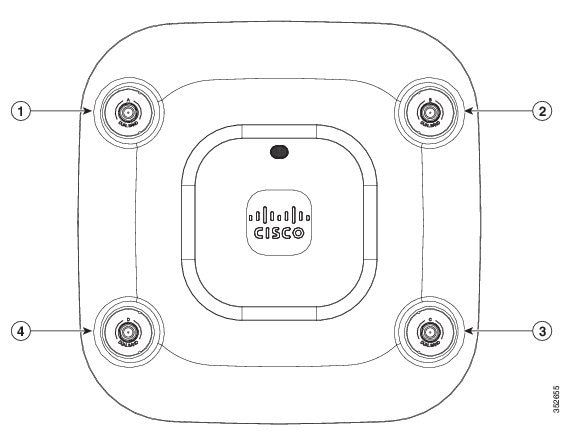
| 1 | Dual-band antenna connector A | 3 | Dual-band antenna connector C |
| 2 | Dual-band antenna connector B | 4 | Dual-band antenna connector D |
Effigy 2 Access Point LED Indicator (peak)—2702I Model
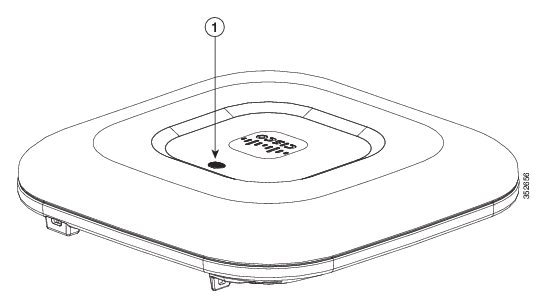
The ports and connections on the bottom of the admission point are shown in Effigy 3.
Effigy 3 Admission Point Ports and Connections (bottom)-AIR2702E and 2702I Models
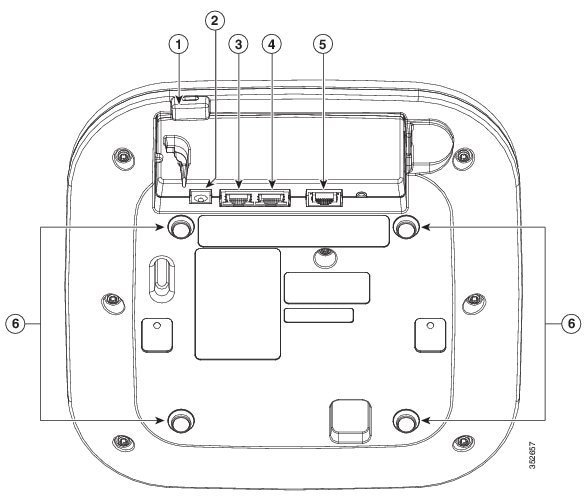
Configuring the Access Point
This department describes how to connect the access point to a wireless LAN controller. Because the configuration process takes place on the controller, see the Cisco Wireless LAN Controller Configuration Guide for additional information. This guide is available on Cisco.com.
The Controller Discovery Process
The access indicate uses standard Command and Provisioning of Wireless Access Points Protocol (CAPWAP) to communicate between the controller and other wireless admission points on the network. CAPWAP is a standard, interoperable protocol which enables an admission controller to manage a collection of wireless termination points. The discovery process using CAPWAP is identical to the Lightweight Access Signal Protocol (LWAPP) used with previous Cisco Aironet access points. LWAPP-enabled admission points are compatible with CAPWAP, and conversion to a CAPWAP controller is seamless. Deployments can combine CAPWAP and LWAPP software on the controllers.
The functionality provided by the controller does not change except for customers who have Layer 2 deployments, which CAPWAP does not support.
In a CAPWAP environment, a wireless admission point discovers a controller by using CAPWAP discovery mechanisms and and so sends it a CAPWAP bring together asking. The controller sends the access bespeak a CAPWAP join response allowing the access indicate to join the controller. When the access indicate joins the controller, the controller manages its configuration, firmware, control transactions, and data transactions.

Notation ![]() For additional information about the discovery process and CAPWAP, run across the Cisco Wireless LAN Controller Software Configuration Guide. This document is available on Cisco.com.
For additional information about the discovery process and CAPWAP, run across the Cisco Wireless LAN Controller Software Configuration Guide. This document is available on Cisco.com.

Note ![]() CAPWAP support is provided in controller software release 5.ii or later. However, your controller must be running release vii.6.120.ten or afterwards to support 2700 series access points.
CAPWAP support is provided in controller software release 5.ii or later. However, your controller must be running release vii.6.120.ten or afterwards to support 2700 series access points.

Note ![]() Y'all cannot edit or query any access point using the controller CLI if the proper name of the access point contains a space.
Y'all cannot edit or query any access point using the controller CLI if the proper name of the access point contains a space.

Note ![]() Brand sure that the controller is ready to the current time. If the controller is set to a time that has already occurred, the access point might not join the controller because its certificate may not exist valid for that time.
Brand sure that the controller is ready to the current time. If the controller is set to a time that has already occurred, the access point might not join the controller because its certificate may not exist valid for that time.
Admission points must be discovered by a controller before they can become an active role of the network. The admission point supports these controller discovery processes:
- Layer iii CAPWAP discovery—Can occur on unlike subnets than the access point and uses IP addresses and UDP packets rather than MAC addresses used by Layer 2 discovery.
- Locally stored controller IP address discovery—If the admission point was previously joined to a controller, the IP addresses of the primary, secondary, and tertiary controllers are stored in the access point's non-volatile memory. This process of storing controller IP addresses on an access point for afterward deployment is called priming the access betoken. For more than information nigh priming, see the "Performing a Pre-Installation Configuration" section.
- DHCP server discovery—This feature uses DHCP choice 43 to provide controller IP addresses to the access points. Cisco switches support a DHCP server option that is typically used for this capability. For more data about DHCP option 43, meet the "Configuring DHCP Pick 43 and DHCP Choice lx" department.
- DNS discovery—The admission signal tin can discover controllers through your domain proper name server (DNS). For the access betoken to do so, yous must configure your DNS to return controller IP addresses in response to CISCO-CAPWAP-CONTROLLER.localdomain, where localdomain is the access point domain name. Configuring the CISCO-CAPWAP-CONTROLLER provides backwards compatibility in an existing customer deployment. When an access signal receives an IP address and DNS information from a DHCP server, it contacts the DNS to resolve CISCO-CAPWAP-CONTROLLER.localdomain. When the DNS sends a list of controller IP addresses, the admission signal sends discovery requests to the controllers.
Preparing the Access Betoken
Before yous mount and deploy your access betoken, nosotros recommend that y'all perform a site survey (or use the site planning tool) to make up one's mind the all-time location to install your access point.
You should have the following information about your wireless network available:
- Access point locations.
- Access signal mounting options: below a suspended ceiling, on a apartment horizontal surface, or on a desktop.

Notation ![]() Yous can mount the admission point to a higher place a suspended ceiling but you must purchase additional mounting hardware: See "Mounting the Access Point" section for boosted data.
Yous can mount the admission point to a higher place a suspended ceiling but you must purchase additional mounting hardware: See "Mounting the Access Point" section for boosted data.
- Admission point ability options: power supplied by the recommended external power supply (Cisco AIR-PWR-B), a DC power supply, PoE from a network device, or a PoE power injector/hub (unremarkably located in a wiring closet).

Annotation ![]() Admission points mounted in a building'south environmental airspace must be powered using PoE to comply with safety regulations.
Admission points mounted in a building'south environmental airspace must be powered using PoE to comply with safety regulations.
Cisco recommends that you brand a site map showing access point locations so that you lot can tape the device MAC addresses from each location and return them to the person who is planning or managing your wireless network.
Installation Summary
Installing the access point involves these operations:
- Performing a pre-installation configuration (optional)
- Mounting the access indicate
- Grounding the admission point
- Deploying the admission indicate on the wireless network
Performing a Pre-Installation Configuration
The following procedures ensure that your admission betoken installation and initial operation get as expected. A pre-installation configuration is also known equally priming the admission point. This process is optional.

Note ![]() Performing a pre-installation configuration is an optional process. If your network controller is properly configured, you tin can install your access point in its final location and connect it to the network from in that location. Meet the "Deploying the Access Bespeak on the Wireless Network" section for details.
Performing a pre-installation configuration is an optional process. If your network controller is properly configured, you tin can install your access point in its final location and connect it to the network from in that location. Meet the "Deploying the Access Bespeak on the Wireless Network" section for details.
Pre-Installation Configuration Setup
The pre-installation configuration setup is shown in Figure 4.
Figure 4 Pre-Installation Configuration Setup
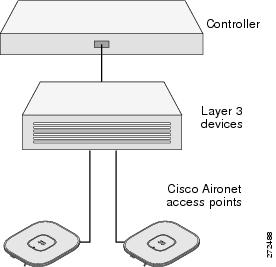
To perform pre-installation configuration, perform the following steps:
Footstep 1 ![]() Make sure that the Cisco wireless LAN controller DS port is connected to the network. Employ the CLI, spider web-browser interface, or Cisco Prime number Infrastructure procedures as described in the appropriate Cisco wireless LAN controller guide.
Make sure that the Cisco wireless LAN controller DS port is connected to the network. Employ the CLI, spider web-browser interface, or Cisco Prime number Infrastructure procedures as described in the appropriate Cisco wireless LAN controller guide.
a. ![]() Brand sure that access points accept Layer 3 connectivity to the Cisco wireless LAN controller Management and AP-Director Interface.
Brand sure that access points accept Layer 3 connectivity to the Cisco wireless LAN controller Management and AP-Director Interface.
b. ![]() Configure the switch to which your admission point is to attach. Come across the Cisco Wireless LAN Controller Configuration Guide, Release x.10 for additional information.
Configure the switch to which your admission point is to attach. Come across the Cisco Wireless LAN Controller Configuration Guide, Release x.10 for additional information.
c. ![]() Set the Cisco wireless LAN controller as the master then that new access points always join with it.
Set the Cisco wireless LAN controller as the master then that new access points always join with it.
d. ![]() Make sure DHCP is enabled on the network. The access point must receive its IP accost through DHCP.
Make sure DHCP is enabled on the network. The access point must receive its IP accost through DHCP.
e. ![]() CAPWAP UDP ports must not be blocked in the network.
CAPWAP UDP ports must not be blocked in the network.
f. ![]() The access point must be able to find the IP address of the controller. This tin can be achieved using DHCP, DNS, or IP subnet circulate. This guide describes the DHCP method to convey the controller IP accost. For other methods, refer to the production documentation. Meet also the "Using DHCP Option 43" section for more information.
The access point must be able to find the IP address of the controller. This tin can be achieved using DHCP, DNS, or IP subnet circulate. This guide describes the DHCP method to convey the controller IP accost. For other methods, refer to the production documentation. Meet also the "Using DHCP Option 43" section for more information.
Step 2 ![]() Apply power to the access signal:
Apply power to the access signal:
a. ![]() The access point should exist powered past whatever 802.3at compliant device.
The access point should exist powered past whatever 802.3at compliant device.
The recommended external ability supply for the admission point is the Cisco AIR-PWR-B ability supply. The access signal tin can also be powered by the following optional external ability sources:
–![]() Access signal ability injector (AIR-PWRINJ4)
Access signal ability injector (AIR-PWRINJ4)
–![]() Any 802.3af compliant power injector is supported, but in this case the access point will dynamically shift from 3x4 to 3x3.
Any 802.3af compliant power injector is supported, but in this case the access point will dynamically shift from 3x4 to 3x3.

Note ![]() The 2702 serial access point requires a gigabit Ethernet (GbE) link to foreclose the Ethernet port from becoming a clogging for traffic because wireless traffic speeds exceed transmit speeds of a ten/100 Ethernet port.
The 2702 serial access point requires a gigabit Ethernet (GbE) link to foreclose the Ethernet port from becoming a clogging for traffic because wireless traffic speeds exceed transmit speeds of a ten/100 Ethernet port.
b. ![]() As the admission betoken attempts to connect to the controller, the LEDs cycle through a green, red, and amber sequence, which tin can take up to five minutes.
As the admission betoken attempts to connect to the controller, the LEDs cycle through a green, red, and amber sequence, which tin can take up to five minutes.

Annotation ![]() If the admission point remains in this manner for more than five minutes, the access betoken is unable to detect the Principal Cisco wireless LAN controller. Check the connectedness between the access point and the Cisco wireless LAN controller and be sure that they are on the aforementioned subnet.
If the admission point remains in this manner for more than five minutes, the access betoken is unable to detect the Principal Cisco wireless LAN controller. Check the connectedness between the access point and the Cisco wireless LAN controller and be sure that they are on the aforementioned subnet.
c. ![]() If the access point shuts down, check the power source.
If the access point shuts down, check the power source.
d. ![]() After the access point finds the Cisco wireless LAN controller, it attempts to download the new operating organisation code if the access point code version differs from the Cisco wireless LAN controller code version. While this is happening, the Status LED blinks dark blue.
After the access point finds the Cisco wireless LAN controller, it attempts to download the new operating organisation code if the access point code version differs from the Cisco wireless LAN controller code version. While this is happening, the Status LED blinks dark blue.
e. ![]() If the operating arrangement download is successful, the access point reboots.
If the operating arrangement download is successful, the access point reboots.
Footstep iii ![]() Configure the admission indicate if required. Use the controller CLI, controller GUI, or Cisco Prime Infrastructure to customize the access-indicate-specific 802.11ac network settings.
Configure the admission indicate if required. Use the controller CLI, controller GUI, or Cisco Prime Infrastructure to customize the access-indicate-specific 802.11ac network settings.
Step iv ![]() If the pre-installation configuration is successful, the Status LED is green indicating normal operation. Disconnect the admission point and mountain it at the location at which yous intend to deploy it on the wireless network.
If the pre-installation configuration is successful, the Status LED is green indicating normal operation. Disconnect the admission point and mountain it at the location at which yous intend to deploy it on the wireless network.
Stride 5 ![]() If your access point does not bespeak normal operation, turn information technology off and repeat the pre-installation configuration.
If your access point does not bespeak normal operation, turn information technology off and repeat the pre-installation configuration.

Note ![]() When you are installing a Layer iii access point on a different subnet than the Cisco wireless LAN controller, be sure that a DHCP server is reachable from the subnet on which yous will exist installing the admission betoken, and that the subnet has a route back to the Cisco wireless LAN controller. Likewise be sure that the route back to the Cisco wireless LAN controller has destination UDP ports 5246 and 5247 open for CAPWAP communications. Ensure that the road back to the principal, secondary, and tertiary wireless LAN controller allows IP bundle fragments. Finally, be sure that if address translation is used, that the access signal and the Cisco wireless LAN controller have a static 1-to-ane NAT to an outside accost. (Port Address Translation is not supported.)
When you are installing a Layer iii access point on a different subnet than the Cisco wireless LAN controller, be sure that a DHCP server is reachable from the subnet on which yous will exist installing the admission betoken, and that the subnet has a route back to the Cisco wireless LAN controller. Likewise be sure that the route back to the Cisco wireless LAN controller has destination UDP ports 5246 and 5247 open for CAPWAP communications. Ensure that the road back to the principal, secondary, and tertiary wireless LAN controller allows IP bundle fragments. Finally, be sure that if address translation is used, that the access signal and the Cisco wireless LAN controller have a static 1-to-ane NAT to an outside accost. (Port Address Translation is not supported.)
Deploying the Admission Point on the Wireless Network
Later you have mounted the access point, follow these steps to deploy it on the wireless network:
Pace 1 ![]() Connect and ability up the access point.
Connect and ability up the access point.
Step 2 ![]() Observe the access point LED (for LED descriptions, see "Checking the Access Point LED" section).
Observe the access point LED (for LED descriptions, see "Checking the Access Point LED" section).
a. ![]() When you power up the admission point, it begins a power-up sequence that y'all tin verify by observing the access point LED. If the power-upwards sequence is successful, the discovery and join process begins. During this process, the LED blinks sequentially green, red, and off. When the access point has joined a controller, the LED is green if no clients are associated or blueish if ane or more than clients are associated.
When you power up the admission point, it begins a power-up sequence that y'all tin verify by observing the access point LED. If the power-upwards sequence is successful, the discovery and join process begins. During this process, the LED blinks sequentially green, red, and off. When the access point has joined a controller, the LED is green if no clients are associated or blueish if ane or more than clients are associated.
b. ![]() If the LED is not on, the access point is most likely not receiving ability.
If the LED is not on, the access point is most likely not receiving ability.
c. ![]() If the LED blinks sequentially for more than than 5 minutes, the admission indicate is unable to observe its main, secondary, and tertiary Cisco wireless LAN controller. Cheque the connection betwixt the access betoken and the Cisco wireless LAN controller, and exist sure the access point and the Cisco wireless LAN controller are either on the aforementioned subnet or that the access point has a route back to its main, secondary, and tertiary Cisco wireless LAN controller. Also, if the access signal is not on the same subnet as the Cisco wireless LAN controller, be certain that in that location is a properly configured DHCP server on the same subnet as the admission point. Run into the "Configuring DHCP Option 43 and DHCP Option 60" section for additional information.
If the LED blinks sequentially for more than than 5 minutes, the admission indicate is unable to observe its main, secondary, and tertiary Cisco wireless LAN controller. Cheque the connection betwixt the access betoken and the Cisco wireless LAN controller, and exist sure the access point and the Cisco wireless LAN controller are either on the aforementioned subnet or that the access point has a route back to its main, secondary, and tertiary Cisco wireless LAN controller. Also, if the access signal is not on the same subnet as the Cisco wireless LAN controller, be certain that in that location is a properly configured DHCP server on the same subnet as the admission point. Run into the "Configuring DHCP Option 43 and DHCP Option 60" section for additional information.
Step iii ![]() Reconfigure the Cisco wireless LAN controller and then that it is not the Principal.
Reconfigure the Cisco wireless LAN controller and then that it is not the Principal.

Annotation ![]() A Principal Cisco wireless LAN controller should be used only for configuring access points and not in a working network.
A Principal Cisco wireless LAN controller should be used only for configuring access points and not in a working network.
Troubleshooting
If you feel difficulty getting your access betoken installed and running, await for a solution to your problem in this guide or in boosted access point documentation. These, and other documents, are available on Cisco.com.
Guidelines for Using Cisco Aironet Lightweight Access Points
Keep these guidelines in listen when you utilise 2702 series lightweight access points:
- The access point tin can only communicate with Cisco wireless LAN controllers.
- The access bespeak does not support Wireless Domain Services (WDS) and cannot communicate with WDS devices. Notwithstanding, the controller provides functionality equivalent to WDS when the admission point joins information technology.
- CAPWAP does not support Layer two. The admission point must get an IP accost and discover the controller using Layer three, DHCP, DNS, or IP subnet circulate.
- The admission point console port is enabled for monitoring and debug purposes. All configuration commands are disabled when the access point is connected to a controller.
Guidelines for Using the Auxiliary Ethernet Port
For Cisco Unified Wireless Networks Release viii.one.102.0 and older, the auxiliary Ethernet port labeled AUX is:
- A non-PoE port.
- Does not provide PoE Out.
- Provided for downward device connectivity only. The port is locally switched and is not managed. Spanning Tree Protocol (STP) is not enabled on this port.
–![]() You lot can connect the AP to end devices such as projectors, phones, Point of Auction Terminals and so on, through this port.
You lot can connect the AP to end devices such as projectors, phones, Point of Auction Terminals and so on, through this port.
–![]() Do non connect another AP or devices such every bit switches or hubs to this port equally they can create spanning loop issues. Too, practice not connect the AUX port to the same uplink switch every bit the AP.
Do non connect another AP or devices such every bit switches or hubs to this port equally they can create spanning loop issues. Too, practice not connect the AUX port to the same uplink switch every bit the AP.
- Appears in the controller user interface every bit GigabitEthernet1.
- Disabled when using 802.3af (15.4W) power.
Checking the Access Point LED
The location of the access point status LED is shown in Figure 2.

Note ![]() Regarding LED condition colors, it is expected that there will exist minor variations in color intensity and hue from unit of measurement to unit of measurement. This is inside the normal range of the LED manufacturer'southward specifications and is not a defect.
Regarding LED condition colors, it is expected that there will exist minor variations in color intensity and hue from unit of measurement to unit of measurement. This is inside the normal range of the LED manufacturer'southward specifications and is not a defect.
The access indicate status LED indicates various atmospheric condition and are described in Tabular array 1.
| Bulletin | Status | Message Significant |
|---|---|---|
| Kick loader status sequence | Blinking green | DRAM retentivity test in progress |
| DRAM memory test OK | ||
| Board initialization in progress | ||
| Initializing Wink file organization | ||
| FLASH memory test OK | ||
| Initializing Ethernet | ||
| Ethernet OK | ||
| Starting Cisco IOS | ||
| Initialization successful | ||
| Association status | Dark-green | Normal operating condition, simply no wireless customer associated |
| Blue | Normal operating status, at least one wireless client clan | |
| Operating status | Blinking blueish | Software upgrade in progress |
| Cycling through dark-green, carmine, and off | Discovery/bring together process in progress | |
| Rapidly cycling through blue, green, and carmine | Access point location command invoked | |
| Blinking red | Ethernet link not operational | |
| Kicking loader warnings | Blinking blue | Configuration recovery in progress (MODE push button pushed for 2 to 3 seconds) |
| Red | Ethernet failure or image recovery (MODE push button pushed for 20 to 30 seconds) | |
| Blinking green | Image recovery in progress (Fashion button released) | |
| Boot loader errors | Red | DRAM retentiveness examination failure |
| Blinking red and blue | FLASH file system failure | |
| Blinking red and off | Environment variable failure | |
| Bad MAC address | ||
| Ethernet failure during image recovery | ||
| Boot environs failure | ||
| No Cisco image file | ||
| Boot failure | ||
| Cisco IOS errors | Ruby-red | Software failure; endeavour disconnecting and reconnecting unit power |
| Cycling through blueish, green, cherry-red, and off | General alarm; insufficient inline power |
Troubleshooting the Access Betoken Join Procedure

Note ![]() The controller must exist running Cisco IOS Software Release 7.6.120.ten or later to support 2700 series access points.
The controller must exist running Cisco IOS Software Release 7.6.120.ten or later to support 2700 series access points.
A detailed explanation of the bring together procedure is on Cisco.com at the following URL:
http://www.cisco.com/c/en/us/back up/docs/wireless/4400-series-wireless-lan-controllers/99948-lap-notjoin-wlc-tshoot.html
Access points tin can fail to bring together a controller for many reasons: a RADIUS authorization is pending; self-signed certificates are not enabled on the controller; the access point'southward and controller'southward regulatory domains don't match, and so on.
Controller software enables you to configure the access points to transport all CAPWAP-related errors to a syslog server. You practise non demand to enable any debug commands on the controller because all of the CAPWAP error letters tin can be viewed from the syslog server itself.
The state of the access point is not maintained on the controller until it receives a CAPWAP join request from the access betoken. Therefore, it tin be difficult to determine why the CAPWAP discovery request from a certain access point was rejected. In lodge to troubleshoot such joining problems without enabling CAPWAP debug commands on the controller, the controller collects information for all access points that transport a discovery message to it and maintains information for any access points that accept successfully joined it.
The controller collects all bring together-related information for each admission betoken that sends a CAPWAP discovery asking to the controller. Collection begins with the first discovery message received from the admission point and ends with the terminal configuration payload sent from the controller to the admission indicate.
Yous can view join-related information for upwardly to three times the maximum number of access points supported past the platform for the 2500 series controllers and the Controller Network Module inside the Cisco 28/37/38xx Series Integrated Services Routers.

Note ![]() The maximum number of admission points varies for the Cisco WiSM2, depending on which controller software release is beingness used.
The maximum number of admission points varies for the Cisco WiSM2, depending on which controller software release is beingness used.
When the controller is maintaining join-related information for the maximum number of access points, it does non collect information for whatsoever more than admission points.
An admission indicate sends all syslog messages to IP address 255.255.255.255 by default when any of the following conditions are met:
- An access betoken running software release seven.6.120.10 or later has been newly deployed.
- An existing access point running software release 7.vi.120.x or afterward has been reset after clearing the configuration.
If any of these weather are met and the admission point has not yet joined a controller, yous can also configure a DHCP server to return a syslog server IP address to the access bespeak using option 7 on the server. The access betoken and then starts sending all syslog messages to this IP address.
When the access point joins a controller for the commencement time, the controller sends the global syslog server IP address (the default is 255.255.255.255) to the access indicate. After that, the access point sends all syslog letters to this IP address until it is overridden past one of the following scenarios:
- The admission signal is still connected to the same controller, and the global syslog server IP address configuration on the controller has been changed using the config ap syslog host global syslog_server_IP_address command. In this instance, the controller sends the new global syslog server IP address to the access point.
- The access indicate is still connected to the same controller, and a specific syslog server IP address has been configured for the access point on the controller using the config ap syslog host specific Cisco_AP syslog_server_IP_address command. In this case, the controller sends the new specific syslog server IP address to the admission point.
- The access point is disconnected from the controller and joins another controller. In this case, the new controller sends its global syslog server IP accost to the access indicate.
- Whenever a new syslog server IP accost overrides the existing syslog server IP address, the old address is erased from persistent storage, and the new address is stored in its place. The access signal likewise starts sending all syslog messages to the new IP address provided the access betoken can reach the syslog server IP address.
You can configure the syslog server for access points and view the access point bring together information merely from the controller CLI.
Declarations of Conformity and Regulatory Information
This section provides declarations of conformity and regulatory information for the Cisco Aironet 2700 Series Access Points. You lot can find additional data at this URL:
world wide web.cisco.com/become/aironet/compliance
Manufacturers Federal Communication Commission Announcement of Conformity Statement
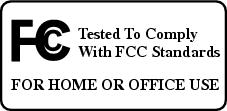
| Access Point Models | Certification Number |
|---|---|
| AIR-CAP2702E-A-K9 | LDK102091 |
Manufacturer:
Cisco Systems, Inc.
170 West Tasman Drive
San Jose, CA 95134-1706
USA
This device complies with Office 15 rules. Operation is subject to the following ii conditions:
1. ![]() This device may not cause harmful interference, and
This device may not cause harmful interference, and
2. ![]() This device must accept any interference received, including interference that may cause undesired operation.
This device must accept any interference received, including interference that may cause undesired operation.
This device operates in the 5150-5250MHz and 5470-5725MHz bands and is therefore restricted to indoor performance only per FCC guidance.
This equipment has been tested and institute to comply with the limits of a Class B digital device, pursuant to Role fifteen of the FCC Rules. These limits are designed to provide reasonable protection against harmful interference when the equipment is operated in a residential environment. This equipment generates, uses, and radiates radio frequency energy, and if not installed and used in accord with the instructions, may cause harmful interference. However, in that location is no guarantee that interference will non occur. If this equipment does crusade interference to radio or television reception, which tin be adamant by turning the equipment off and on, the user is encouraged to correct the interference by ane of the following measures:
- Reorient or relocate the receiving antenna.
- Increase separation between the equipment and receiver.
- Connect the equipment to an outlet on a circuit different from which the receiver is continued.
- Consult the dealer or an experienced radio/TV technician.

Caution ![]() The Part 15 radio device operates on a not-interference ground with other devices operating at this frequency when using the integrated antennas. Any changes or modification to the product not expressly canonical by Cisco could void the user's authority to operate this device.
The Part 15 radio device operates on a not-interference ground with other devices operating at this frequency when using the integrated antennas. Any changes or modification to the product not expressly canonical by Cisco could void the user's authority to operate this device.

Caution ![]() Within the 5.15 to 5.25 GHz and 5.47-5.725 GHz bands, this device is restricted to indoor operations to reduce whatever potential for harmful interference to co-channel Mobile Satellite System (MSS) operations.
Within the 5.15 to 5.25 GHz and 5.47-5.725 GHz bands, this device is restricted to indoor operations to reduce whatever potential for harmful interference to co-channel Mobile Satellite System (MSS) operations.
VCCI Argument for Japan
| Alert | This is a Class B product based on the standard of the Voluntary Control Council for Interference from It Equipment (VCCI). If this is used near a radio or goggle box receiver in a domestic surroundings, it may cause radio interference. Install and apply the equipment according to the pedagogy manual. |
| | |
Guidelines for Operating Cisco Aironet Access Points in Japan
This section provides guidelines for avoiding interference when operating Cisco Aironet access points in Japan. These guidelines are provided in both Japanese and English.
Japanese Translation
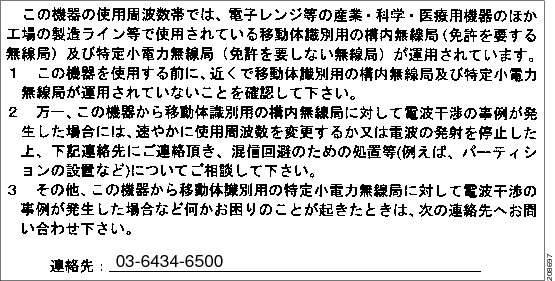
English Translation
This equipment operates in the same frequency bandwidth as industrial, scientific, and medical devices such equally microwave ovens and mobile object identification (RF-ID) systems (licensed premises radio stations and unlicensed specified low-power radio stations) used in factory production lines.
ane. ![]() Earlier using this equipment, make sure that no premises radio stations or specified low-power radio stations of RF-ID are used in the vicinity.
Earlier using this equipment, make sure that no premises radio stations or specified low-power radio stations of RF-ID are used in the vicinity.
2. ![]() If this equipment causes RF interference to a premises radio station of RF-ID, promptly alter the frequency or stop using the device; contact the number beneath and ask for recommendations on fugitive radio interference, such as setting partitions.
If this equipment causes RF interference to a premises radio station of RF-ID, promptly alter the frequency or stop using the device; contact the number beneath and ask for recommendations on fugitive radio interference, such as setting partitions.
iii. ![]() If this equipment causes RF interference to a specified low-power radio station of RF-ID, contact the number beneath.
If this equipment causes RF interference to a specified low-power radio station of RF-ID, contact the number beneath.
Contact Number: 03-6434-6500
Statement 371—Power Cable and AC Adapter

English Translation
When installing the product, delight use the provided or designated connection cables/power cables/Air-conditioning adaptors. Using any other cables/adaptors could cause a malfunction or a fire. Electric Appliance and Textile Prophylactic Constabulary prohibits the utilize of UL-certified cables (that have the "UL" shown on the lawmaking) for whatever other electrical devices than products designated by CISCO. The utilise of cables that are certified by Electrical Appliance and Material Safety Law (that have "PSE" shown on the code) is not limited to CISCO-designated products.
Manufacture Canada
Canadian Compliance Statement
| Access Betoken Models | Certification Number |
|---|---|
| AIR-CAP2702E-A-K9 | 2461B-102091 |
This Class B Digital apparatus meets all the requirements of the Canadian Interference-Causing Equipment Regulations.
This device complies with Course B Limits of Industry Canada. Operation is subject to the following 2 atmospheric condition:
ane. ![]() This device may not crusade harmful interference, and
This device may not crusade harmful interference, and
2. ![]() This device must accept any interference received, including interference that may cause undesired operation.
This device must accept any interference received, including interference that may cause undesired operation.
Cisco Aironet Admission Points are certified to the requirements of RSS-210. The use of this device in a system operating either partially or completely outdoors may require the user to obtain a license for the system according to the Canadian regulations. For further information, contact your local Industry Canada function.
This device has been designed to operate with antennas having a maximum proceeds of 6 dBi. Antennas having a gain greater than vi dBi are strictly prohibited for employ with this device. The required antenna impedance is fifty ohms.
To reduce potential radio interference to other users, the antenna type and its gain should be and so chosen that the equivalent isotropically radiated ability (EIRP) is not more than that permitted for successful communication.
Operation in the band 5150-5250 MHz is merely for indoor use to reduce the potential for harmful interference to co-channel mobile satellite systems.
Users are advised that high-power radars are allocated as primary users (i.e. priority users) of the bands 5250-5350 MHz and 5650-5850 MHz and that these radars could cause interference and/or impairment to LE-LAN devices.
French Translation
Cet appareil numerique de la classe B respecte les exigences du Reglement sur le material broilleur du Canada.
Cet appareil respecte les limites prescrites pour les appareils de classe B par Industrie Canada. Son utilisation est soumise aux deux weather suivantes :
(i) Cet appareil ne doit pas causer d'interférences nuisibles, et
(2) Cet appareil doit accepter toutes les interférences, y compris celles susceptibles de perturber le fonctionnement de fifty'appareil.
Les points d'acces Aironet de Cisco sont certifiés conformément aux exigences du CNR-210. 50'utilisation de cet appareil dans un système fonctionnant partiellement ou entièrement à l'extérieur peut nécessiter l'obtention d'une licence pour le système,conformément à la règlementation canadienne. Pour plus de renseignements, communiquez avec le bureau local d'Industrie Canada.
Cet appareil a été conçu pour fonctionner avec une antenne d'un proceeds maximum de 6 dBi. Il est strictement interdit d'utiliser des antennes ayant un gain supérieur à half-dozen dBi avec cet appareil. L'antenne doit avoir une impédance de l ohms.
Afin de réduire le risque d'interférence aux autres utilisateurs, le type d'antenne et son gain doivent être choisis de façon à ce que la puissance isotrope rayonnée équivalente (p.i.r.e.) ne soit pas supérieure au niveau requis pour obtenir une advice satisfaisante.
La bande 5 150-5 250 MHz est réservés uniquement pour une utilisation à l'intérieur afin de réduire les risques de brouillage préjudiciable aux systèmes de satellites mobiles utilisant les mêmes canaux.
Les utilisateurs êtes avisés que les utilisateurs de radars de haute puissance sont désignés utilisateurs principaux (c.-à-d., qu'ils ont la priorité) pour les bandes v 250-five 350 MHz et v 650-5 850 MHz et que ces radars pourraient causer du brouillage et/ou des dommages aux dispositifs LAN-EL.
European Community, Switzerland, Kingdom of norway, Iceland, and Liechtenstein
Admission Bespeak Models:
AIR-CAP2702E-Eastward-K9
AIR-CAP2702I-E-K9
Declaration of Conformity with regard to the R&TTE Directive 1999/v/EC & Medical Directive 93/42/EEC
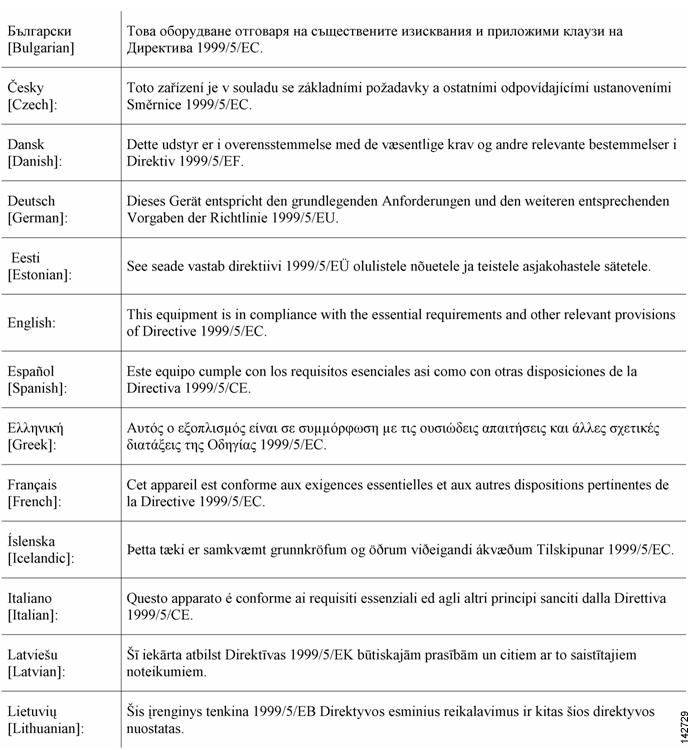
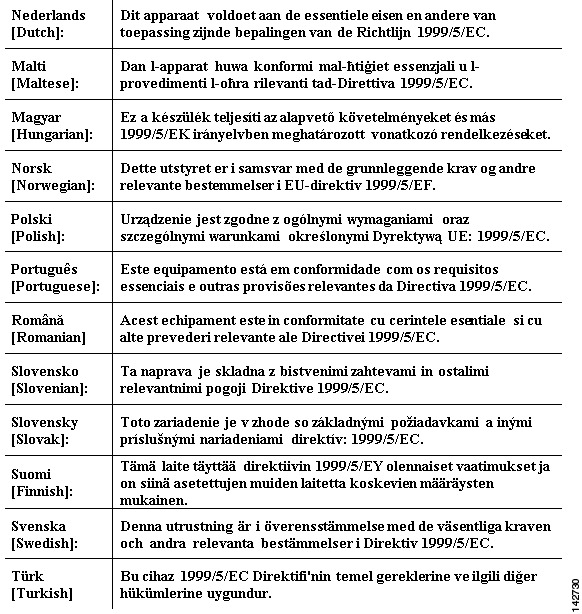
The following standards were practical:
EMC—EN 301.489-ane v1.viii.1; EN 301.489-17 v2.1.1
Health & Rubber—EN60950-1: 2005; EN 50385: 2002
Radio—EN 300 328 v 1.vii.1; EN 301.893 5 i.5.1
The conformity assessment procedure referred to in Article 10.iv and Addendum 3 of Directive 1999/5/EC has been followed.
This device also conforms to the EMC requirements of the Medical Devices Directive 93/42/EEC.

Note ![]() This equipment is intended to be used in all European union and EFTA countries. Outdoor use may be restricted to certain frequencies and/or may crave a license for operation. For more details, contact Cisco Corporate Compliance.
This equipment is intended to be used in all European union and EFTA countries. Outdoor use may be restricted to certain frequencies and/or may crave a license for operation. For more details, contact Cisco Corporate Compliance.
The product carries the CE Mark:

Announcement of Conformity for RF Exposure
This department contains information on compliance with guidelines related to RF exposure.
Generic Discussion on RF Exposure
The Cisco products are designed to comply with the following national and international standards on Homo Exposure to Radio Frequencies:
- United states 47 Code of Federal Regulations Part ii Subpart J
- American National Standards Establish (ANSI) / Institute of Electrical and Electronic Engineers / IEEE C 95.1 (99)
- International Commission on Not Ionizing Radiations Protection (ICNIRP) 98
- Ministry of Wellness (Canada) Prophylactic Code half dozen. Limits on Human Exposure to Radio Frequency Fields in the range from 3kHz to 300 GHz
- Australia Radiations Protection Standard
To ensure compliance with various national and international Electromagnetic Field (EMF) standards, the organization should only be operated with Cisco approved antennas and accessories.
This Device Meets International Guidelines for Exposure to Radio Waves
The 2700 series device includes a radio transmitter and receiver. It is designed not to exceed the limits for exposure to radio waves (radio frequency electromagnetic fields) recommended by international guidelines. The guidelines were developed by an independent scientific organization (ICNIRP) and include a substantial rubber margin designed to ensure the safety of all persons, regardless of historic period and wellness.
As such the systems are designed to be operated equally to avoid contact with the antennas by the end user. Information technology is recommended to set the arrangement in a location where the antennas can remain at least a minimum altitude equally specified from the user in accordance to the regulatory guidelines which are designed to reduce the overall exposure of the user or operator.
| Separation Altitude | ||
|---|---|---|
| MPE | Distance | Limit |
| 0.63 mW/cm2 | twenty cm (seven.87 inches) | 1.00 mW/cm2 |
The Earth Wellness Organization has stated that present scientific data does not signal the need for whatsoever special precautions for the use of wireless devices. They recommend that if you are interested in further reducing your exposure then you lot can easily do so by reorienting antennas away from the user or placing he antennas at a greater separation distance so recommended.
This Device Meets FCC Guidelines for Exposure to Radio Waves
The 2700 series device includes a radio transmitter and receiver. Information technology is designed not to exceed the limits for exposure to radio waves (radio frequency electromagnetic fields) as referenced in FCC Office 1.1310. The guidelines are based on IEEE ANSI C 95.ane (92) and include a substantial safety margin designed to ensure the condom of all persons, regardless of age and health.
Equally such the systems are designed to be operated as to avert contact with the antennas by the finish user. It is recommended to set the system in a location where the antennas can remain at least a minimum distance as specified from the user in accordance to the regulatory guidelines which are designed to reduce the overall exposure of the user or operator.
The device has been tested and constitute compliant with the applicable regulations as part of the radio certification process.
| Separation Altitude | ||
|---|---|---|
| MPE | Distance | Limit |
| 0.63 mW/cm2 | 20 cm (7.87 inches) | 1.00 mW/cm2 |
The The states Food and Drug Administration has stated that nowadays scientific data does non bespeak the need for any special precautions for the employ of wireless devices. The FCC recommends that if y'all are interested in further reducing your exposure then y'all can hands practice so by reorienting antennas away from the user or placing the antennas at a greater separation distance then recommended or lowering the transmitter power output.
This Device Meets the Industry Canada Guidelines for Exposure to Radio Waves
The 2700 series device includes a radio transmitter and receiver. Information technology is designed not to exceed the limits for exposure to radio waves (radio frequency electromagnetic fields) every bit referenced in Health Canada Prophylactic Code six. The guidelines include a substantial prophylactic margin designed into the limit to ensure the safety of all persons, regardless of age and health.
As such the systems are designed to be operated as to avoid contact with the antennas past the end user. It is recommended to set the system in a location where the antennas tin can remain at least a minimum distance as specified from the user in accordance to the regulatory guidelines which are designed to reduce the overall exposure of the user or operator.
| Separation Distance | ||
|---|---|---|
| MPE | Distance | Limit |
| 0.63 mW/cm2 | xx cm (vii.87 inches) | 1.00 mW/cm2 |
Wellness Canada states that present scientific data does not indicate the need for whatever special precautions for the use of wireless devices. They recommend that if you are interested in farther reducing your exposure yous can hands do so past reorienting antennas abroad from the user, placing the antennas at a greater separation distance than recommended, or lowering the transmitter power output.
Cet appareil est conforme aux directives internationales en matière d'exposition aux fréquences radioélectriques
Cet appareil de la gamme 1700 comprend un émetteur-récepteur radio. Il a été conçu de manière à respecter les limites en matière d'exposition aux fréquences radioélectriques (champs électromagnétiques de fréquence radio), recommandées dans le code de sécurité 6 de Santé Canada. Ces directives intègrent une marge de sécurité importante destinée à assurer la sécurité de tous, indépendamment de fifty'âge et de la santé.
Par conséquent, les systèmes sont conçus pour être exploités en évitant que l'utilisateur due north'entre en contact avec les antennes. Il est recommandé de poser le système là où les antennes sont à une distance minimale telle que précisée par l'utilisateur conformément aux directives réglementaires qui sont conçues pour réduire fifty'exposition générale de 50'utilisateur ou de l'opérateur.
| Altitude d'éloignement | ||
|---|---|---|
| MPE | Distance | Limite |
| 0.63 mW/cm2 | 20 cm (vii.87 po) | 1.00 mW/cm2 |
Santé Canada affirme que la littérature scientifique actuelle n'indique pas qu'il faille prendre des précautions particulières lors de l'utilisation d'united nations appareil sans fil. Si vous voulez réduire votre exposition encore davantage, selon l'agence, vous pouvez facilement le faire en réorientant les antennes afin qu'elles soient dirigées à fifty'écart de l'utilisateur, en les plaçant à une distance d'éloignement supérieure à celle recommandée ou en réduisant la puissance de sortie de l'émetteur.
Boosted Data on RF Exposure
Y'all can detect additional information on the subject at the post-obit links:
- Cisco Systems Wireless Systems and RF Safe Issues White Paper at this URL:
http://www.cisco.com/c/en/us/products/collateral/wireless/aironet-1200-access-signal/prod_white_paper09186a0080088791.pdf
- FCC Bulletin 56: Questions and Answers almost Biological Effects and Potential Hazards of Radio Frequency Electromagnetic Fields
- FCC Bulletin 65: Evaluating Compliance with the FCC guidelines for Man Exposure to Radio Frequency Electromagnetic Fields
- FCC Bulletin 65C (01-01): Evaluating Compliance with the FCC guidelines for Human being Exposure to Radio Frequency Electromagnetic Fields: Boosted Information for Evaluating Compliance for Mobile and Portable Devices with FCC limits for Human Exposure to Radio Frequency Emission
You lot tin can obtain additional information from the post-obit organizations:
- Earth Wellness Organization Internal Commission on Non-Ionizing Radiation Protection at this URL: www.who.int/emf
- Great britain, National Radiological Protection Board at this URL: http://www.nrpb.org.britain/
- Cellular Telecommunications Association at this URL: http://www.ctia.org/
- The Mobile Manufacturers Forum at this URL: http://world wide web.mmfai.org/
Administrative Rules for Cisco Aironet Admission Points in Taiwan
This section provides administrative rules for operating Cisco Aironet admission points in Taiwan. The rules for all admission points are provided in both Chinese and English.
Chinese Translation
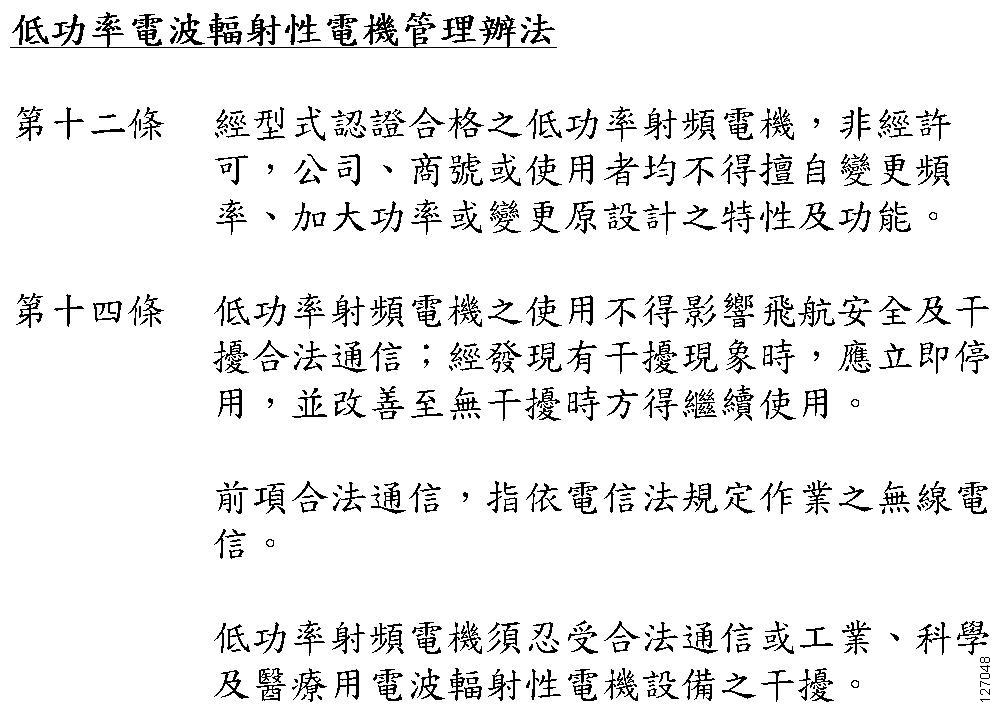
English language Translation
Administrative Rules for Low-power Radio-Frequency Devices
Article 12
For those low-power radio-frequency devices that have already received a blazon-approval, companies, business units or users should not change its frequencies, increase its power or modify its original features and functions.
Article xiv
The performance of the low-power radio-frequency devices is discipline to the atmospheric condition that no harmful interference is caused to aviation safety and authorized radio station; and if interference is caused, the user must stop operating the device immediately and tin can't re-operate it until the harmful interference is clear.
The authorized radio station means a radio-communication service operating in accordance with the Advice Act.
The operation of the low-ability radio-frequency devices is subject to the interference caused by the functioning of an authorized radio station, by another intentional or unintentional radiator, past industrial, scientific and medical (ISM) equipment, or past an incidental radiator.
Chinese Translation
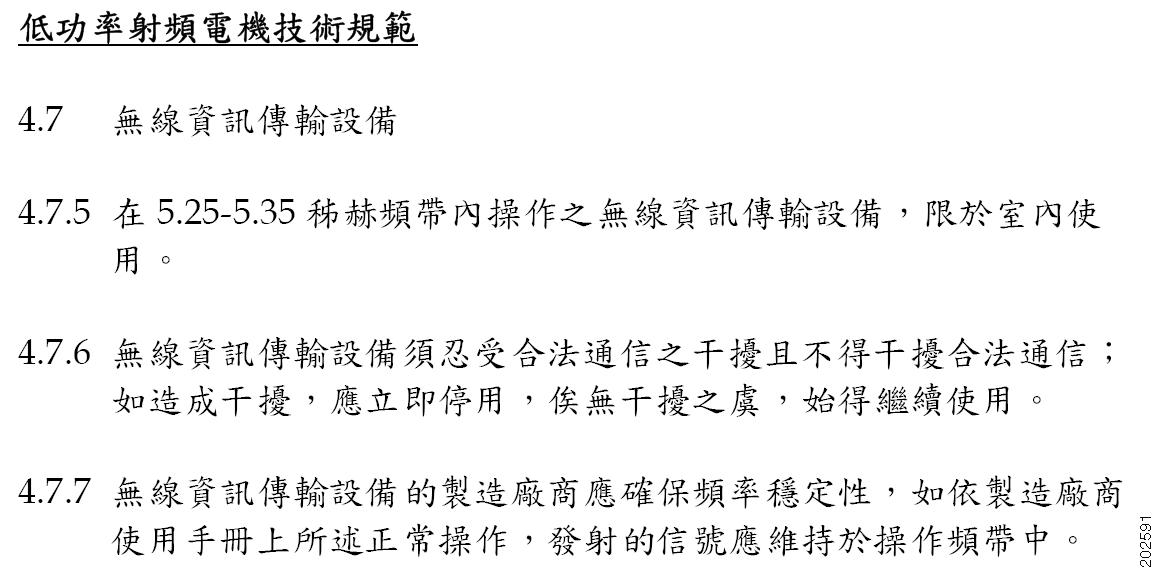
English Translation
Depression-ability Radio-frequency Devices Technical Specifications
| 4.7 | Unlicensed National Information Infrastructure |
| 4.7.5 | Within the 5.25-5.35 GHz band, U-NII devices volition be restricted to indoor operations to reduce any potential for harmful interference to co-channel MSS operations. |
| 4.seven.6 | The U-NII devices shall accept any interference from legal communications and shall not interfere the legal communications. If interference is caused, the user must stop operating the device immediately and tin can't re-operate it until the harmful interference is clear. |
| 4.7.vii | Manufacturers of U-NII devices are responsible for ensuring frequency stability such that an emission is maintained within the ring of functioning under all weather condition of normal operation as specified in the user manual. |
Operation of Cisco Aironet Admission Points in Brazil
This section contains special information for operation of Cisco Aironet access points in Brazil.
Admission Indicate Models:
AIR-CAP2702E-Z-K9
AIR-CAP2702I-Z-K9
Regulatory Information
Figure 5 contains Brazil regulatory information for the access point models identified in the previous section.
Figure 5 Brazil Regulatory Information
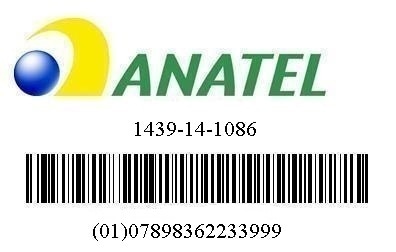
Portuguese Translation
Este equipamento opera em caráter secundário, isto é, não tem direito a proteção contra interferência prejudicial, mesmo de estações do mesmo tipo, e não pode causar interferência a sistemas operando em caráter primário.
English Translation
This equipment operates on a secondary footing and consequently must accept harmful interference, including interference from stations of the aforementioned kind. This equipment may not crusade harmful interference to systems operating on a primary basis.
Proclamation of Conformity Statements
All the Declaration of Conformity statements related to this product can exist found at the following location: http://www.ciscofax.com
Configuring DHCP Pick 43 and DHCP Pick 60
This section contains a DHCP Option 43 configuration example on a Windows 2003 Enterprise DHCP server for utilize with Cisco Aironet lightweight access points. For other DHCP server implementations, consult product documentation for configuring DHCP Choice 43. In Option 43, yous should use the IP address of the controller management interface.

Note ![]() DHCP Option 43 is limited to i access bespeak type per DHCP pool. You must configure a separate DHCP pool for each admission point type.
DHCP Option 43 is limited to i access bespeak type per DHCP pool. You must configure a separate DHCP pool for each admission point type.
The 2700 series access point uses the blazon-length-value (TLV) format for DHCP Option 43. DHCP servers must be programmed to return the option based on the admission point's DHCP Vendor Class Identifier (VCI) string (DHCP Selection lx). The VCI string for the 2700 series admission point is:
Cisco AP c2700

Note ![]() If your access indicate was ordered with the Service Provider Option (AIR-OPT60-DHCP) selected in the ordering tool, the VCI string for the admission signal contains ServiceProvider. For example, a 2700 with this option volition return this VCI string:
If your access indicate was ordered with the Service Provider Option (AIR-OPT60-DHCP) selected in the ordering tool, the VCI string for the admission signal contains ServiceProvider. For example, a 2700 with this option volition return this VCI string:
Cisco AP c2700-ServiceProvider
The format of the TLV block is listed below:
- Type: 0xf1 (decimal 241)
- Length: Number of controller IP addresses * 4
- Value: List of WLC management interfaces
To configure DHCP Choice 43 in the embedded Cisco IOS DHCP server, follow these steps:
Step 1 ![]() Enter configuration mode at the Cisco IOS CLI.
Enter configuration mode at the Cisco IOS CLI.
Footstep 2 ![]() Create the DHCP pool, including the necessary parameters such as default router and name server. A DHCP telescopic example is equally follows:
Create the DHCP pool, including the necessary parameters such as default router and name server. A DHCP telescopic example is equally follows:
ip dhcp pool <pool name>
network <IP Network> <Netmask>
default-router <Default router>
dns-server <DNS Server>
Where:
<pool proper noun> is the name of the DHCP pool, such as AP2702
<IP Network> is the network IP accost where the controller resides, such as 10.0.15.1
<Netmask> is the subnet mask, such equally 255.255.255.0
<Default router> is the IP address of the default router, such every bit 10.0.0.1
<DNS Server> is the IP address of the DNS server, such as 10.0.x.2
Footstep 3 ![]() Add together the option 60 line using the following syntax:
Add together the option 60 line using the following syntax:
option lx ascii "VCI cord"
For the VCI string, "Cisco AP c2700". The quotation marks must be included.
Stride four ![]() Add the option 43 line using the following syntax:
Add the option 43 line using the following syntax:
option 43 hex <hex string>
The hex cord is assembled by concatenating the TLV values shown beneath:
Type + Length + Value
Type is e'er f1(hex). Length is the number of controller management IP addresses times 4 in hex. Value is the IP address of the controller listed sequentially in hex.
For instance, suppose that in that location are two controllers with direction interface IP addresses, 10.126.126.2 and ten.127.127.2. The blazon is f1(hex). The length is 2 * 4 = eight = 08 (hex). The IP addresses translate to 0a7e7e02 and 0a7f7f02. Assembling the string then yields f1080a7e7e020a7f7f02. The resulting Cisco IOS command added to the DHCP scope is option 43 hex f1080a7e7e020a7f7f02.
Cisco Air Cap2702i E K9 Standalone,
Source: https://www.cisco.com/c/en/us/td/docs/wireless/access_point/2700/quick/guide/ap2700getstart.html
Posted by: meadmathesembed1977.blogspot.com




0 Response to "Cisco Air Cap2702i E K9 Standalone"
Post a Comment